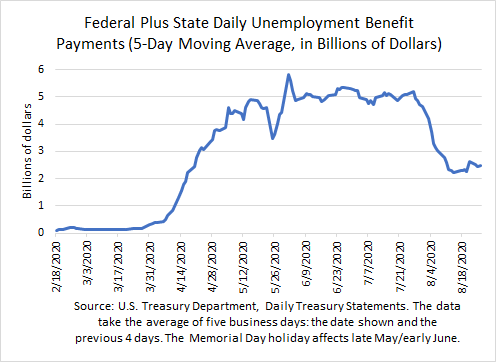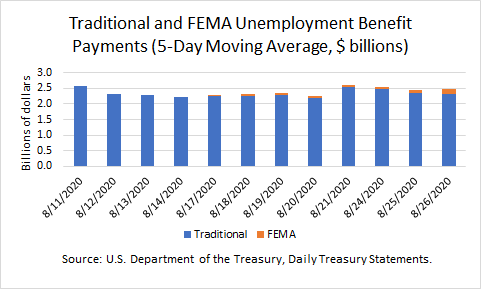Posted on August 27, 2020

About a month after the expiration of the extra $600 weekly federal unemployment benefit, we have seen total benefits paid start to move back up again. A five-day moving average of the total national amount of payments of state and federal unemployment benefits had reached about $5 billion per day for most of June and July, but then dropped steadily to just above $2 billion per day in the middle of August, presumably at that point representing mostly all state benefits (see chart above). In recent days, with the last day recorded being Wednesday, August 26, those benefit payments have climbed slightly and are running closer to $2.5 billion daily.
The emergency lost wage payments from the Federal Emergency Management Agency (FEMA), which were established by the President’s executive action of August 8 and total $300 per week for qualifying unemployment benefit recipients, have begun in a few states. Those FEMA payments are effectively additional unemployment benefits. However, amounts paid out are very small right now, registering about $170 million daily on average over the past week–about 7 percent of total state and federal benefits paid (see the second chart, shown below). (As an aside, note that some of the increase in overall benefit payments in the past week was unrelated to FEMA payments.) As more states complete the process of applying and getting approved for the FEMA program, and updating their systems to make the proper payments, presumably total benefits should continue to rise back up; they shouldn’t approach the previous $5 billion per day level given the cut in the federal benefit from $600 to $300, although the retroactive nature of the FEMA benefits means that we could see some temporary jumps. Nonetheless, as currently structured, the emergency federal funds may only last for a little over a month, give or take, and the retroactive nature of the FEMA benefits means that we could see benefits jump and then the available funds quickly run out thereafter. Could recipients in states that are slower in updating their systems to make the payments miss out altogether? We’ll see if any negotiations between the Administration and Congress bring back higher federal unemployment benefits through legislation, although for now that is looking unlikely.
